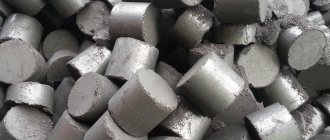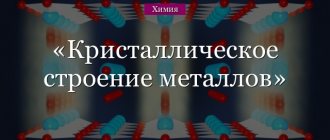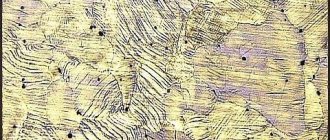Main menu> | Study work
Graphitized cast irons
Depending on the shape of the graphite inclusions, gray, high-strength, malleable cast iron and cast iron with vermicular graphite are distinguished.
Gray cast iron
obtained at a lower casting cooling rate than white castings. They contain 1–3% Si, which has a strong graphitizing effect.
Gray cast iron is widely used in mechanical engineering. It can be processed well with cutting tools. It is used to produce machine beds, cylinder blocks, foundation frames, cylinder liners, pistons, etc.
Gray cast iron according to GOST 1412–85 is marked with the letters “СЧ” and is followed by the tensile strength value (in kg/mm2
), for example SCh 15, SCh 20, SCh 35 (Table 1).
Graphite in gray cast iron is observed in the form of dark inclusions on a light background of an unetched section. The shape and dispersion of graphite, on which the mechanical properties of gray cast iron largely depend, are assessed from an unetched section.
Gray cast irons are divided according to the microstructure of the metal base, depending on the completeness of graphitization.
The degree or completeness of graphitization is assessed by the amount of freely released (unbound) carbon.
The completeness of graphitization depends on many factors, the main ones being the cooling rate and the composition of the alloy. With rapid cooling, the formation of cementite rather than graphite is kinetically more favorable. The slower the cooling, the greater the degree of graphitization. Silicon promotes graphitization, and manganese, a carbide-forming element, hinders graphitization.
Rice. 3. Diagrams of microstructures of graphitized cast irons: a) gray; b) high strength; c) malleable; d) with vermicular graphite
If graphitization in the solid state is complete, then cast iron contains two structural components - graphite and ferrite. This alloy is called gray cast iron on a ferritic basis (Fig. 3, a). If the eutectoid decomposition of austenite took place in accordance with the metastable system
then the structure of cast iron consists of graphite and perlite. This alloy is called pearlite-based gray cast iron. Finally, an intermediate option is possible when austenite partially decomposes by eutectoid reaction into ferrite and graphite, and partially with the formation of pearlite. In this case, cast iron contains three structural components - graphite, ferrite and pearlite. This alloy is called gray cast iron on a ferrite-pearlite base.
Ferrite and pearlite in the metal base of cast iron have the same microstructural characteristics as in steels. Gray cast irons contain an increased amount of phosphorus, which increases fluidity and produces a triple eutectic.
In the metal base of gray cast iron, phosphide eutectic is found in the form of light, well-defined areas.
Ductile irons
with nodular graphite are obtained by modifying gray cast iron with alkaline earth elements. More often, magnesium is used for this, introducing it into the liquid melt in an amount of 0.02–0.03%. Under the influence of magnesium, graphite crystallizes in a spherical shape (Fig. 3, b). Spherical graphite inclusions in a metal matrix are not as strong stress raisers as graphite plates in gray cast iron. Nodular cast irons have higher mechanical properties that are not inferior to cast carbon steel.
High-strength cast iron is marked according to GOST 7293–85 with the letters “HF” and then follows the value of the tensile strength (in kg/mm2
), for example HF 40, HF 45, HF 80 (Table 2). Just like gray cast irons, they are divided according to the microstructure of the metal base depending on the completeness of graphitization and can be ferritic, ferrite-pearlitic and pearlitic. High-strength cast iron is used in many areas of technology to replace cast and forged steel, gray and ductile cast iron. High mechanical properties make it possible to widely use it for the production of critical-use castings, including in marine engineering: cylinder heads, turbochargers, pressure pipes, crankshafts and camshafts, etc.
Malleable cast irons
obtained by annealing white cast iron castings.
The production of malleable cast iron is based on the fact that instead of the unstable cementite of white cast iron, annealing graphite of white cast iron is formed at elevated temperatures. Small products of complex configuration, cast from white cast iron, are annealed (malleable cast iron is obtained) to impart sufficient ductility necessary for their use in work. Malleable cast iron according to GOST 1215–79 is marked with the letters “KCh” and is followed by the value of tensile strength (in kg/mm2
) and relative elongation (in%), for example, KCh 35-10, KCh 60-3 (Table 3) .
Graphitization occurs through the dissolution of metastable cementite in austenite and the simultaneous separation of more stable graphite from the austenite. The longer the holding time during annealing and the lower the cooling rate, the more complete the graphitization occurs. Depending on the graphitization, the same three main types of structures are found as in gray cast iron: malleable cast irons on ferritic, ferrite-pearlitic and pearlitic bases (Fig. 3, c). Ductile cast irons differ from gray (foundry) cast irons in microstructure only in the form of graphite.
If in thin sections (Fig. 3, a) of gray cast iron graphite has the form of tortuous veins, then in malleable cast iron graphite, called annealing carbon, is in the form of more compact flake-like inclusions with torn edges. The more compact form of graphite provides increased mechanical properties of ductile iron compared to gray cast iron with flake graphite. Having mechanical properties similar to cast steel and high-strength cast iron, high resistance to impact loads, wear resistance, and machinability, ductile cast iron finds its application in many industries. Pistons, gears, connecting rods, brackets, porthole rings, etc. are made from it.
Cast irons with vermicular graphite
They are obtained, like high-strength cast irons, by modification, only a complex modifier containing magnesium and rare earth metals is introduced into the melt.
Cast irons with vermicular graphite are marked according to GOST 28394–89 with the letters “ChVG” and followed by a number indicating the value of the tensile strength ( kg/mm2
), for example, ChVG 30, ChVG 45 (Table 4). Vermicular graphite, like lamellar graphite, is visible on a metallographic section in the form of veins, but they are smaller, thicker, with rounded edges (Fig. 3, d). The microstructure of the metal base of ChVG, like that of other graphitized cast irons, can be ferritic, pearlitic and ferrite-pearlite.
In terms of mechanical properties, cast irons with vermicular graphite are superior to gray cast irons and are close to high-strength cast irons, and the damping capacity and thermophysical properties of CCG are higher than those of high-strength cast irons.
Cast irons with vermicular graphite are more technologically advanced than high-strength cast irons and compete with gray cast irons. They are characterized by high fluidity, good machinability, and low shrinkage. Cast irons with vermicular graphite are widely used in the global and domestic automotive industry, tractor manufacturing, shipbuilding, diesel engineering, power and metallurgical engineering for parts operating under significant mechanical loads under conditions of wear, hydrocavitation, and variable temperature increases. For example, ChVG is used for the production of cylinder covers and liners, pistons for ship and diesel engines, gas turbine and compressor casings. Top of page
Composition and types of white cast iron
White cast iron consists of the so-called cementite eutectic. In this regard, it is divided into three categories:
- Hypoeutectic. These are alloys in which carbon does not exceed 4.3% of the total composition. It is obtained after complete cooling. As a result, it acquires the characteristic structure of such elements as pearlite, secondary cementite and ledeburite.
- Eutectic. Their carbon content is 4.3%.
- Hypereutectic white cast iron. The content exceeds 4.35% and can reach 6.67%.
In addition to the above classification, it is divided into ordinary, bleached and alloyed.
The internal structure of white cast iron is an alloy of two elements: iron and carbon. Despite high-temperature production, it retains a fine-grained structure. Therefore, if you break a part made of such metal, a characteristic white color will be observed. In addition, in the structure of a hypoeutectic alloy, for example, hard grades, in addition to pearlite and secondary cementite, cementite is always present. Its percentage can approach 100%. This is typical for a eutectic metal. For the third type, the structure is a composition of eutectic (Ep) and primary cementite.
One of the varieties of such alloys is the so-called bleached cast iron. Its basis, that is, the core, is gray or high-strength cast iron. The surface layer contains a high percentage of elements such as ledeburite and perlite. The whitening effect up to 30 mm deep is achieved using the rapid cooling method. As a result, the surface layer is white, and then the casting consists of an ordinary gray alloy.
White cast iron structure
Depending on the percentage of alloyed additives, the following types of metal are distinguished:
- low-alloyed (they contain no more than 2.5% alloying elements);
- moderately alloyed (the percentage of such elements reaches 10%);
- highly alloyed (in them the amount of alloying additives exceeds 10%).
Quite common elements are used as alloying additives. The alloyed white cast iron obtained in this way acquires new, predetermined properties.
Properties of white cast iron
Any cast iron alloy, on the one hand, is very strong, but at the same time it is quite brittle. Therefore, the main positive properties of white cast iron include:
- High hardness. This greatly complicates the processing of parts, in particular cutting.
- Very high resistivity.
- Excellent wear resistance.
- Good resistance to increased heat.
- Sufficient corrosion resistance, including to various acids.
White cast irons, with a reduced percentage of carbon, are more resistant to high temperatures. This property is used to reduce the number of cracks in castings.
Appearance of white cast iron
The disadvantages include:
- Low casting properties. It has poor mold filling. During pouring, internal cracks may form.
- Increased fragility.
- Poor machinability of castings and parts made of white cast iron.
- Large shrinkage, which can reach 2%.
- Low impact resistance.
Another disadvantage is poor weldability. Problems in welding parts made of this material are caused by the fact that during welding, cracks form, both during heating and cooling.
Marking of white cast iron
To mark white cast iron, letters of the Russian alphabet and numbers are used. If it contains impurities, then the marking begins with the letter “H”. The composition of the available alloying additives can be determined by the following letters P, PL, PF, PVK. They indicate the presence of silicon. If the resulting metal has increased wear resistance, then its marking will begin with the letter “I”, for example ICHH, ICH. For example, the presence of the designation “Ш” in the marking means that the alloy structure contains spherical graphite.
The numbers indicate the amount of additional substances present in white cast iron.
Brand CHN20D2ХШ is deciphered as follows. This is a heat-resistant high-alloy metal. It contains the following elements: nickel - 20%, copper - 2%, chromium - 1%. The remaining elements are iron, carbon, and spherical graphite.
Structure of gray cast iron
When assessing the structure of gray cast iron
determine the size (in microns) of graphite inclusions, their distribution and quantity (in percentage), as well as the type of structure of the metal base and the dispersion of pearlite (if present).
According to the structure of the metal base, gray cast iron
divided into
pearlitic
,
ferrite-pearlitic
,
ferritic
(
Figure C-1
).
To designate the components of the structure of gray cast iron, symbols according to GOST 3443-87 are used. Thus, flake graphite in gray cast iron is designated by the letters PG. The forms of graphite inclusions in the structure of gray cast iron can be:
- plate straight (PGf1);
- plate vortex (PGf2);
- acicular (PGf3);
- nest-shaped (PGf4).
The structure of cast iron is of paramount importance for obtaining the specified properties of the casting, therefore, compliance with the technological regimes of melting and pouring is required. The modification operation helps to obtain the desired structure of gray cast iron and get rid of defects.
How to determine the grade of cast iron?
Grades of cast iron in the foundry industry are usually designated by letters indicating the basic nature or purpose of the cast iron:
- SCH - gray cast iron,
- HF - high strength,
- KCh - malleable; for anti-friction cast iron, the letter A is indicated at the beginning of the grade (ASCh, AVCH, AKCH).
Interesting materials:
Can beans be planted in July? Is it possible to plant hazelnuts in the shade? Is it possible to plant potatoes with very long shoots? Is it possible to plant dogwood in the shade? Can clematis be planted in a pot? Is it possible to plant onions in the shade? Is it possible to plant carrots and beets? Is it possible to plant a nut near the house? Is it possible to plant ferns in the yard? Is it possible to plant two peppers in one hole?











